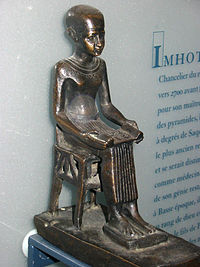Imhotep
Imhotep was a high priest and a doctor in ancient Egypt. Imhotep also became famous as an architect. Imhotep was the architect, physician, scribe, and chief advisor of the 3rd-Dynasty pharaoh Djoser. He was later worshipped as a god. As a god, he was often pictured seated, wearing a long kilt robe and a skull cap or a shaven head. He had a papyrus scroll spread on his lap to show he was a scribe and a scholar.

Step pyramid
changeAs an architect, Imhotep was most famous because he was the designer of the step pyramid at Sakkara. Before the step pyramid, pharaohs were buried in flat topped buildings called mastabas. The term mastaba comes from the word meaning bench, because they look like the benches most Egyptians placed outside their door. An average mastaba had four walls, a flat top and an underground burial chamber, reached by a vertical shaft or stairwell.The step pyramid was actually just a number of mastabas placed one on top of the other, each one smaller than the previous one. There were also a couple of small rooms above the burial chambers with items for the afterlife.
Medical writer
changeImhotep’s best-known writings were medical scrolls. He is thought to have written the Edwin Smith papyrus. The papyrus lists 48 injuries of which 27 are head trauma, and six are spine trauma. Here’s an example for treatment of a head injury:
“Examination: If thou examinest a man having a wound in his head, while his wound does not have two lips, penetrating to the bone of his skull, (but) not having a gash, thou shouldst palpate his wound (or, thou shouldst lay thy hand upon it); shouldst thou find his skull uninjured, not having a perforation; a split, or a smash in it. Treatment: Thou shouldst bind it with fresh meat the first day (and) treat afterwards with grease, honey (and) lint every day until he recovers wound in the head”
This article does not have any sources. (July 2010) |
Becoming a god
changeAround 100 years after his death, Imhotep was deified (made into a god). Imhotep became the god of medicine and healing. Small temples were built in honor of him. People with injuries would sleep near his temple hoping to be healed. As a god, Imhotep was also worshiped by scribes. Scribes would offer a couple drops of water as a sacrifice to him before starting to write. Because of his attachment with the god Ptah during his work at Ptah's temple, stories were spread that said that Ptah was his father.
Even when the Greeks took over Egypt in 331 B.C.E., he was identified with another deified man called Asclepius, and the Greeks continued to honor and build temples for him.
References
change- Thames and Hudson The Complete Gods and Goddesses Of Ancient Egypt
- Remler, Pat Egyptian mythology A to Z
- Tyldesly, Joyce Egypt
- Freeman, Charles The Legacy of Ancient Egypt
- Nardo, Don Ancient Egypt
- Encyclopedia Britainia